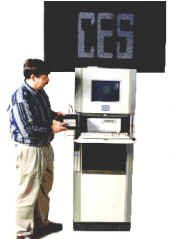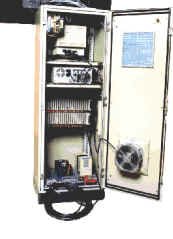|
|
|
|
|
|
|
|
|
|
|
Model 7 Brochure
Pattern Design
Screen Shots
|
|
| TC3000
- Model 7 |
|
Here Bill Otto is shown with the portable keyboard/display terminal
that has been used in all 200 previous control systems installed
over the past 12 years. All new systems are downward compatible
both from use and functionality of this terminal. The terminal is
connected to the computer via a long cable such that its position
can be in close proximity of a fixer (running diagnostic programs),
as well as the operator at the machine.
These same functions and displays are operational
via the computer keyboard and color monitor, with obvious additional
features available with the color monitor, displaying additional
information, patterns, for example.
As mentioned, the portable keyboard/display functions
are the same as older models, but also old pattern (diskette) files;
older patterns will run on the newer control systems. The portable
terminal functions are also operational via the computer keyboard
/ monitor.
|
 |
|
|
| |
|
 |
|
From the rear of the cabinet, the back of the monitor
is shown in the top, then the computer, then the interface card
rack – cables can be seen at the top of the cabinet. These
connect the circuits in the interface card rack to the solenoids
on the machine.
Some systems have a servo system under the interface
card rack (not shown here) that controls a servo motor on the machine.
The servo system operates in sync with the rug pattern such that
the backing is advanced in fixed steps. The backing motion begins
on the needle upstroke when the needles clear the backing, with
motion completion before the needles reenter the backing on the
downstroke. The step distance is part of the pattern, and determines
the stitch count, as well as eliminating backing motion when the
needles are in the fabric.
In the bottom are power filtering, isolation and
regulating components. The coil of cables at the bottom connect
to position sensors on the machine.
An air system can be seen on the rear door.
|
|
|
|
|
|
|
|
|
|
|
|
|
|
|
|
|
|
|
 |
|
Industry standard Euro Cards
and racks are used. Each rack holds up to 20 solenoid interface pc
boards, with 64 output circuits per board, resulting in control capability
of 1,280 output signals per rack. The cabinet can hold 4 racks (extensions
can be added) for a total per cabinet of 5,120 control outputs. We
currently have a system quoted with over 14,000 outputs.
The (coiled) ribbon cable shown is connected to the back of the
card rack and has a machine wiring interface at the other end, depending
upon the application. In this case, there is a solenoid interface
pc board with a terminal strip to which machine solenoid wires are
terminated.
|
|
|
|
|
|
|
|
|
|
|
|
|
|
|
|
|
|
|
 |
|
The solenoid interface pc board
connector pins come through the card rack backplane and the ribbon
cable connects directly to the solenoid interface pc board connector,
thus reducing the number of connections and in turn enhancing connection
reliability. |
|
|
|
|
|
|
|
|
|
|
|
|
|
|
|
|
|
 |
|
The front of the
solenoid interface pc board has 64 red LEDs in series with 64 corresponding
solenoids, and only illuminate when each corresponding solenoid is
drawing current. Hence, the LED is a true indication of computer,
circuit, and machine wiring integrity. The solenoid output circuits
are fused on the pc board so as to protect against both solenoid and
machine wiring faults; fuses plug into pin sockets for easy replacement.
Fusing other than on the pc board may not give complete protection.
On the pc board end plate is a number next to each LED for identification.
The illumination pattern of all pc boards is seen through a smoked
glass front panel.
Any pc board plugs into any slot in the rack. Each pc board has
an on-board power supply (regulator/rectifier) for both the pc board
power and solenoid power, so as to eliminate the need for two large
power supplies that could take out the entire system.
|
|
|
|
|
|
|
|
|
|
|
|
|
|
|
|
|
 |
|
A (programmable)
control pc board in each card rack allows configuration of the rack
to the specific machine. Some machines have multiple controls per
yarn end, such as high/low plus cut/uncut. Two control outputs are
needed per yarn end, and these outputs can be mapped on this board. |
|
|
|
|
|
|
|
|
|
|
|
|
|
|
|
|
 |
|
This picture shows floor mats
coming off a production Colortec machine controlled by a model 7 CES
controller. |
|
|
|
|
Home | Products | News |
Downloads | Info |
|
|
|
|
|
|
|
|
|
|
|
|

